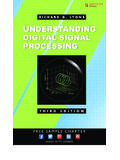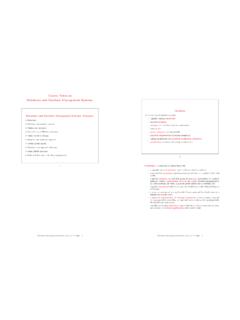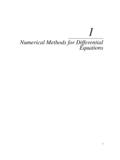Transcription of Chapter 2 Discrete-time Signals and Systems
1 Chapter 2. Discrete-time Signals and Systems Discrete-time Signals Digital Signals are discrete in both time (the independent variable) and amplitude (the dependent variable). Signals that are disrete in time but continuous in amplitude are referred to as Discrete-time Signals . Discrete-time Signals are data sequences. A sequence of data is denoted {x[n]} or simply x [n] when the meaning is clear. The elements of the sequence are called samples. The index n associated with each sample is an integer. If appropriate, the range of n will be specified. Quite often, we are interested in identifying the sample where n = 0. This is done by putting an arrow under that sample. For instance, {x[n]} ={.. , ,1, , , 2,..}.. The arrow is often omitted if it is clear from the context which sample is x[0]. Sample values can either be real or complex. In the rest of this book, the terms Discrete-time Signals and sequences are used interchangeably. The time interval between samples is not explicitly shown.
2 It can be assumed to be normalized to 1 unit of time . So the corresponding normalized sampling frequency is 1. Hz. If the actual sampling interval is T seconds, then the sampling frequency is given by fs = T1 . 20 Discrete-time Signals and Systems 2. Amplitude 1. 0. 3 2 1 0 1 2 3 4. Index (n). Figure : The Unit Impulse Sequence Some Elementary Sequences There are some sequence that we shall encounter frequently. They are described here. Unit Impulse Sequence The unit impulse sequence is defined by . 1, n = 0. [n] = ( ). 0, n =. 6 0. This is depicted graphically in Figure Note that while the continuous- time unit im- pulse function is a mathematical object that cannot be physically realized, the unit im- pulse sequence can easily be generated. Unit Step Sequence The unit step sequence is one that has an amplitude of zero for negative indices and an amplitude of one for non-negative indices. It is shown in Figure Discrete-time Signals 21. 2. Amplitude 1. 0. 3 2 1 0 1 2 3 4.
3 Index (n). Figure : The Unit Step Sequence Sinusoidal Sequences A sinusoidal sequence has the form x[n] = A cos ( 0 n + ) ( ). This function can also be decomposed into its in-phase xi [q] and quadrature xq [n] com- ponents. x[n] = A cos cos 0 n A sin sin 0 n ( ). = xi [n] + xq [n] ( ). This is a common practice in communications signal processing. Complex Exponential Sequences Complex exponential sequences are essentially complex sinusoids. x[n] = Aej( o n+ ) ( ). = A cos( 0 n + ) + jA sin( 0 n + ) ( ). 22 Discrete-time Signals and Systems Amplitude 0. 0 5 10 15 20 25 30. Index (n). Figure : Uniformly distributed random sequence with amplitudes between and Random Sequences The sample values of a random sequence are randomly drawn from a certain probability distribution. They are also called stochastic sequences. The two most common distribu- tions are the Gaussian (normal) distribution and the uniform distribution. The zero-mean Gaussian distribution is often used to model noise.
4 Figure and figure show exam- ples of uniformly distributed and Gaussian distributed random sequences respectively. Types of Sequences The Discrete-time Signals that we encounter can be classified in a number of ways. Some basic classifications that are of interest to us are described below. Real vs. Complex Signals A sequence is considered complex at least one sample is complex-valued. Discrete-time Signals 23. 2. 1. Amplitude 0. 1. 2. 0 5 10 15 20 25 30. Index (n). Figure : Gaussian distributed random sequence with zero mean and unit variance. Finite vs. Infinite Length Signals Finite length sequences are defined only for a range of indices, say N1 to N2 . The length of this finite length sequence is given by |N2 N1 + 1|. Causal Signals A sequence x[n] is a causal sequence if x[n] = 0 for n < 0. Symmetric Signals First consider a real-valued sequence {x[n]}. Even symmetry im- plies that x[n] = x[ n] and for odd symmetry x[n] = x[n] for all n. Any real-valued sequence can be decomposed into odd and even parts so that x[n] = xe [n] + xo [n].
5 Where the even part is given by 1. xe [n] = (x[n] + x[ n]). 2. and the odd part is given by 1. xo [n] = (x[n] x[ n]). 2. 24 Discrete-time Signals and Systems A complex-valued sequence is conjugate symmetric if x[n] = x? [ n]. The sequence has conjugate anti-symmetry if x[n] = x? [ n]. Analogous to real-valued sequences, any complex-valued sequence can be decomposed into its conjugate symmetric and conjugate anti-symmetric parts: x[n] = xcs [n] + xca [n] ( ). 1. xcs [n] = (x[n] + x? [ n]) ( ). 2. 1. xca [n] = (x[n] x? [ n]) ( ). 2. Periodic Signals A Discrete-time sequence is periodic with a period of N samples if x[n] = x[n + kN ] ( ). for all integer values of k. Note that N has to be a positive integer. If a sequence is not periodic, it is aperiodic or non-periodic. We know that continuous- time sinusoids are periodic. For instance, the continuous- time signal x(t) = cos ( 0 t) ( ). has a frequency of 0 radians per second or f0 = 0 /2 Hz. The period of this sinusoidal signal is T = 1/f0 seconds.
6 Now consider a Discrete-time sequence x [n] based on a sinusoid with angular frequency 0 : x[n] = cos ( 0 n) ( ). If this sequence is periodic with a period of N samples, then the following must be true: cos 0 (n + N ) = cos 0 n ( ). However, the left hand side can be expressed as cos 0 (n + N ) = cos ( 0 n + 0 N ) ( ). and the cosine function is periodic with a period of 2 and therefore the right hand side of ( ) is given by cos 0 n = cos ( 0 n + 2 r) ( ). Discrete-time Signals 25. for integer values of r. Comparing ( ) with ( ), we have 0 N =2 r 2 f0 N =2 r r f0 = ( ). N. where 0 = 2 f0 . Since both r and N are integers, a Discrete-time sinusoidal sequence is periodic if its frequency is a rational number. Otherwise, it is non-periodic.. Example Is x[n] = cos 8 n periodic? If so, what is the period? The sequence can be expressed as . 1. x[n] = cos 2 n 16. So in this case, f0 = 1/16 is a rational number and the sinusoidal sequence is periodic with a period N = 16.
7 Example Determine the fundamental period of the following sequence: x[n] = cos ( n) + sin ( n). Solution: For the cosine function, the angular frequency is 1 = = 2 ( ) = 2 f1. Therefore, 55. f1 =. 100. 11. =. 20. and the period is N1 = 20. For the sine function, the angular frequency is 2 = = 2 ( ) = 2 f2. 26 Discrete-time Signals and Systems where 35. f2 =. 100. 7. =. 20. and the period is N2 = 20. So the period of x[n] is 20. It is interesting to note that for Discrete-time sinusoidal sequences, a small change in frequency can lead to a large change in period. For example, a certain sequence has frequency f1 = = 51/100. So its period is 100 samples. Another sinusoidal sequence with frequency f2 = = 50/100 has a period of only 2 samples since f2. can be simplified to 1/2. Thus a frequency difference of can cause the period of the two sinusoidal sequences to differ by 98 samples! Another important point to note is that Discrete-time sinusoidal sequences with frequen- cies separated by an integer multiple of 2 are identical.
8 Energy and Power Signals The energy of a finite length sequence x[n] is defined as N2. X. E= |x[n]|2 ( ). n=N1. while that for an infinite sequence is . X. E= |x[n]|2 ( ). n= . Note that the energy of an infinite length sequence may not be infinite. A signal with finite energy is usually referred to as an energy signal . Example Find the energy of the infinite length sequence n 2 , n 0. x[n] =. 0, n<0. Discrete-time Signals 27. According to the definition, the energy is given by n X. 2n X 1. E= 2 =. n=0 n=0. 4. To evaluate the finite sum, first consider N. X 1. SN = an = 1 + a + a2 + + aN 1 ( ). n=0. Multiplying this equation by a, we have aSN = a + a2 + + aN ( ). and the difference between these two equations give SN aSN = (1 a) SN = 1 aN ( ). Hence if a 6= 1, 1 aN. SN = ( ). 1 a For a = 1, it is obvious that SN = N . For a < 1, the infinite sum is therefore 1. S = ( ). 1 a Making use of this equation, the energy of the signal is 1 4. E= =. 1 1/4 3. Equations ( ) and ( ) are very useful and we shall be making use of them later.
9 The average power of a periodic sequence with a period of N samples is defined as N 1. 1 X. Px = |x[n]|2 ( ). N n=0. and for non-periodic sequences, it is defined in terms of the following limit if it exists: K. 1 X. Px = lim |x[n]|2 ( ). K 2K + 1. n= K. A signal with finite average power is called a power signal . 28 Discrete-time Signals and Systems Example Find the average power of the unit step sequence u[n]. The unit step sequence is non-periodic, therefore the average power is . 1 X. P = lim u2 [n]. K 2K + 1. n=0. K +1. = lim K 2K + 1. 1. =. 2. Therefore the unit step sequence is a power signal . Note that its energy is infinite and so it is not an energy signal . Bounded Signals A sequence is bounded if every sample of the sequence has a mag- nitude which is less than or equal to a finite positive value. That is, |x[n]| Bx < ( ). Summable Signals A sequence is absolutely summable if the sum of the absolute value of all its samples is finite. X . |x[n]| < ( ). n=.
10 A sequence is square summable if the sum of the magnitude squared of all its samples is finite.. X. |x[n]|2 < ( ). n= . Some Basic Operations on Sequences Scaling Scaling is the multiplication of a scalar constant with each and every sample value of the sequence. This operation is depicted schematically in Figure Addition Addition of two sequences usually refers to point-by-point addition as shown in Figure Discrete-time Signals 29. x[n] A Ax[n]. Figure : Scalar Multiplication by A. x[n] y[n]=x[n]+w[n]. w[n]. Figure : Point-by-point Addition Delay A unit delay shifts a sequence by one unit of time as shown in Figure A. sequence x[n] is delayed by N samples to produce y[n] if y[n] = x[n N ]. Up/Down Sampling Down-sampling by a factor of L (a positive integer) is an opera- tion by which only one every L-th sample of the original sequence is kept, with the rest discarded. The schematic for a down-sampler is shown in Figure The down-sampled signal y[n] is given by y[n] = x[nM ] ( ).







